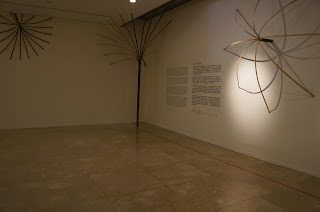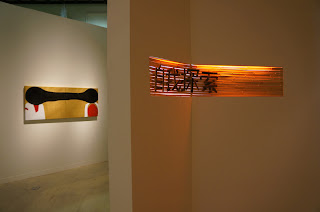Idas, Getting back to the roots
那路 很會彎-第三屆原住民藝術工作者駐村計畫聯展
那路 很會彎-第三屆原住民藝術工作者駐村計畫聯展
Naruwan--Life finds a way—Taiwan Indigenous Artists Exhibition 2012
謹訂於2012年3月17日(星期六)下午三時
於高雄市立美術館雕塑大廳舉行 開幕典禮
孫大川 行政院原住民族委員會主委
史 哲 高雄市政府文化局局長
謝佩霓 高雄市立美術館館長
吳茂昆 國立東華大學校長
潘小雪 策展人/國立東華大學藝術學院院長
達卡鬧 音樂表演藝術總監
陳文生、許坤仲等42位原住民藝術工作者
- 敬 邀 -
記者會:2012年3月16日上午11:00
展覽時間 2012年3月17日至2012年5月27日
展覽地點 高雄市立美術館104-105展覽室
開幕時間 2012年3月17日下午3時
開幕演出 2012年3月17日下午6:30-8:30 (憑演出請柬入場)
演出二場 2012年3月18日上午10:00-12:00 (特別邀請弱勢團體及自由入場)
主辦單位 行政院原住民族委員會
合辦單位 高雄市立美術館
承辦單位 國立東華大學藝術學院
協辦單位 台灣原住民族文化園區
本展覽經費由 財政部公益彩劵回饋金 提供
繼2010年「走出來的路」,本館再度與行政院原住民委員會及國立東華大學藝術學院共同策劃「那路很會彎-第三屆原住民藝術工作者駐村計畫聯展」。本展覽將藝術工作者作品內容思想加以分類,展出五類主題,共計42位藝術工作者80件以上作品,另外薪傳成就類有卑南族的哈古以及排灣族的許坤仲,就其一生的成就分享給觀眾與族人。
那路很會彎 ── 第三屆原住民藝術工作者駐村計畫聯展
策展人 潘小雪
國立東華大學藝術學院院長
「那魯灣」一詞原先來自阿美族歌謠,後來廣泛應用在台灣各族,它是虛詞或是打招呼的發語詞,沒有確定的指涉意義,但是每個人都可以賦予它感覺的詮釋,例如:開心的呼喚、表達善意、情感的期待等。本策展理念應用這個辭語加以轉化成為有意義的美學概念。《那路很會彎》的「路」指的是繼2010年本計劃在高美館《走出來的路》展覽,原住民藝術創作者走出自己的路、走出傳統之路的後續發展狀況。
藝術家創作的途徑一直保持在自我與大地、世界的對應交流中,緩緩向前行,原住民藝術工作者也不例外。當他們摸索打開了意義的盒子,一時之間許多的議題如土地正義、美好文化、自我探索、素材實驗、流行創新、教育關懷、永恆傳唱、文化身體等,並時性的開展出來,創作之路從最早單純的出發點,曲曲折折走向意義的那一端,這些途徑交織成為自己的世界圖像。
《那路很會彎》除了表現上述的思想之外,也有一種輕鬆自由的意思,在部落中,「很會~」這生活用語有「頑皮地讚許」或「挑釁的激賞」的語氣,表現原住民族在應用有限的漢語時,恰到好處地表達對世俗價值不急不緩的性情,也想充分表現國立東華大學藝術學院與高雄市立美術館在歷經兩屆駐村計畫的執行與合作中,致力於原住民藝術家的創作環境與展現,讓社會看見其中的發展軌跡及特殊性。
本次展覽主辦單位行政院原住民委員會在四年前向財政部爭取公益彩券回饋基金,規劃辦理「原住民藝術家駐村促進部落在地就業3年計畫」,至今已進入第三屆,補助的藝術工作者共計115位,對於台灣原住民族的生命力與創造力之提升貢獻很大。本次展覽共展出42位藝術工作者作品,展出者為:陳文生(哈古)、許坤仲、鄭林貴鳳、謝水能、沈萬順、張梅娘、彼得洛.烏嘎、雷恩、達比烏蘭.古勒勒、安聖惠、尼誕.達給伐歷、宜徳思.盧信、撒部.噶照、馬躍.比吼、陳安琪、林介文、廖光亮、高獻庭、林琳、馬郁芳、秦榮輝、伊誕.巴瓦瓦隆、舒米.如妮、張世凱、施雅香、謝美如、莊蒼菁、高勝忠、河蘭英、楊亞君、武玉玲、陳春花、李雅馨、東冬.侯溫、廖怡馨、碧斯蔚.梓佑、方敏全、阿努.卡力亭.沙力朋安、林廣材、以莉.高露 、達鳳.旮赫地、安君毅等,其中哈古與許坤仲兩位前輩是薪傳成就者。
本計畫在徵選的行政作業上,以一般藝術分類方式分為視覺藝術類、創意產業類、音樂表演類、薪傳成就等。然而,藝術工作者一旦進入創作的世界卻不會被這種分類所限制,他們互跨領域,擴張成多元的形式內容,還原藝術本來的面貌。本展覽以藝術工作者各自所發展出來的五個類型:自我探索、部落時尚、文化身體、經典薪傳、土地方面等分類展出。除了讓欣賞者了解藝術工作者所關懷的存在問題之外,同時也企圖建構原住民族創作的美學體系。高雄市立美術館在台灣原住民當代藝術的長年耕耘,加上其展覽專業團隊的規劃協助,使我們得以將原住民藝術中原始的創發精神展現出來。
藝術家拉黑子.達立夫曾多次提出「原住民藝術家」這個用詞在論述上的尷尬處境,藝術家就是藝術家,為何要加上「原住民」?就像「素人藝術家」這個用詞沒有意義一樣,我們不能忽視加上「原住民」這個詞將被特殊看待,很可能被當代藝術排除在外。但是另一方面,為了要彰顯一種特殊的藝術風格是由某些特殊族群所創造出來的又不得不標示其國名或族名,這種處境很快就被反省著。紀錄導演馬躍.比吼極力批判原住民族在社會中為甚麼要扮演唱歌跳舞給人家看的那一群?台灣最有特色的樂舞,為何如此不由分說的變成了弄臣?他一方面在提醒藝術家要有自覺與矜持,一方面也警告社會不可草率對待;台灣東岸不少的藝術工作者參與還我土地、反財團破壞環境的自覺運動;林介文在花蓮瑞穗紅葉部落號召族人展出《翻了》;舒米在石梯坪舉辦為期一個月的創作營《米粑流-水梯田藝術音樂季》;廖怡馨與雷恩在台北誠品的展演《戀念百合》,表現文化的身體等等。本屆藝術工作者大都能用現代媒材創作並且提出自我探索、社會批判、部落創造、存在自覺的新形式,這都說明了原住民藝術家創作途徑走向當代藝術的路上。
Naruwan -- Life finds a way
—Taiwan Indigenous Artists Exhibition 2012
Press Conference:2012.3.16 11:00AM
Exhibition Dates: 2012.3.17~2012.5.27
Exhibition Venue: Galleries 104 and 105, Kaohsiung Museum of Fine Arts
Opening Ceremony: 2012.3.17 3:00PM
Performance: 2012.3.17 6:30~8:30PM
Performance: 2012.3.18 10:00~12:00AM
Supported by: Council of Indigenous Peoples, Executive Yuan
Coordinated by: Kaohsiung Museum of Fine Arts
Organized by: College of the Arts, National Dong Hwa University
Assisted by: Taiwan Indigenous Peoples Culture Park
Sponsored by: The fund of non-profit Lottery, Ministry of Finance
Naruwan--Life finds a way
—Taiwan Indigenous Artists Exhibition 2012
Curator: Pan Hsiao-hsueh, National Institute of the Arts, National Dong Hwa University
After “Evolving Beyond the Past” in 2010, the KMFA worked again this year withthe Council of Indigenous Peoples of Executive Yuan and the College of the Artsat National Dong Hwa University in jointly organizing this exhibition. It showcasesover 80 works by 42 artists. The works are divided into five categories based on theircontents and themes. In particular, the category of “Torch-passing Achievement”features Haku from the Puyuma Tribe and Pairang.Pavavaljung from the PaiwanTribe, enabling viewers and their tribal men to witness and share the lifelong artisticachievements of these two outstanding indigenous artists.
Artists' creative paths are always located near the point of confluence of the self, the earth, and the world. They are gradually moving forward, and indigenous artists are no exception. When they pried open the box of meanings, such various and sundry issues as land justice, cultural beauty, concern for education, eternal song, and the cultural body all emerged at that moment. From its earliest, purest, starting point, their artistic paths have continued along twisting and turning courses toward the other end of meaning. These paths have been woven into their own picture of the world.
Apart from expressing this thinking, On the Way also signifies a sense of easy-going freedom. In indigenous villages, the expression "hen hui"—used in the Chinese name of this exhibition—perfectly expresses indigenous people's balanced attitude toward worldly values when used in a mischievously or provocatively praising tone of voice. This expression also conveys the developmental pathway and uniqueness of indigenous artists in the wake of two artist-in-residence programs conducted cooperatively by the College of the Arts, National Dong Hwa University and Kaohsiung Museum of Fine Arts, which have striven to improve the creative environment and presentation of indigenous artists.
This exhibition's organizer, the Council of Indigenous Peoples, Executive Yuan, obtained funds from the Ministry of Finance's Public Welfare Lottery Contribution Fund for the implementation of the "Indigenous Artist-in-Residence Three-year Program Promoting Local Village Employment." Currently in its third phase, this program has provided funding to a total of 115 art workers, and has made an enormous contribution to boosting the vitality and creativity of indigenous artists in Taiwan. This exhibition displays works by 42 artists, including Haku.Kasabaknv, Pairang.Pavavaljung, Kereker, Giljegiljau, Djakudjakuc, Lahok, Pitayro.Ukah, Kulele.Lei, Tapuwoan.kulele, Elen.Lolowan, Nitjan.Takivalit, Idas.Losin, Sapud.Kacaw, Mayaw.Biho, Thalaelethe.Titibu, Labay.Neyong, Zudweyi.Ruvaniyao, Kuciling.Katatepan, Malay.Makaluwan, Aruwai.Matilin, Qarucangij,
Etan.Pavavaljung, Sumi.Dongi, Sirman.misarkoa, Si.UoLing,
Siwa.Yumin, Avai.Nuacaciana, Sabula,Gader.Aderves, Sayun.Dumun, Aluaiy.pulidan, Kedrekedre, Pisuy.Buyung, DonDon.Hounwn, Luzen.Madjilin, Pisui.Ciyo, Mo`o, Anu.Kaliting.Sadipongan, Ngerenger, Ilid.Kaolo,
Tafong.Kati and Laucu.Luluan. Of these, the older-generation artists Haku and Pairang.Pavavaljung are recognized as passers of the torch.
This project's recruiting and selection administrative procedures used an ordinary art classification system to classify works as visual art, creative industry works, musical performances, and torch-passing achievement. Nevertheless, art workers are not subject to the restrictions of this type of classification scheme once they enter the art world, but are instead able to expand into new, interdisciplinary areas and diverse artistic form, returning to the original, unified appearance of art. The works in this exhibition are displayed in five categories devised by the artists themselves: self-exploration, village fashions, the cultural body, classical transmission, and land justice. Apart from letting viewers understand the existential problems of concern to the artists, the exhibition also attempts to construct a creative aesthetic system for Taiwan's indigenous peoples. In addition to the Kaohsiung Museum of Fine Arts' long-term efforts to promote Taiwan's contemporary indigenous art, our professional exhibition team's planning and assistance have enabled us to highlight the raw creative spirit of indigenous art.
Artist Rahic Talifo has said many times that use of the term "indigenous artists" in discussion leads to embarrassing situations—artists are artists; why is the qualifier "indigenous" needed? This is as meaningless as saying a "portrait artist." We should not ignore the reality that the adjective "indigenous" attracts special attention; it will probably be discarded in contemporary art. However, another aspect is that it may be necessary to affix the name of a country or ethnicity to highlight the fact that some works have a special artistic style has been created by a special group of people. This situation requires immediate reflection. Director Mayaw Biho has asked, "Why should indigenous peoples want to play the role singers and dancers for others in society. Why should Taiwan's most distinctive performers be made as court jesters in such an unreasonable manner?" Mayaw reminds artists to maintain a sense of self-awareness and restraint, which will also warn society to not treat them rashly. Numerous artists on Taiwan's east coast have participated in the "Return our land, oppose environmental destruction by large corporate groups" self-awareness movement. Lin Chieh-wen called on the indigenous residents of Hongye Village near Ruisui in Hualien County to display "Fanle." Sumi Dongi held the one-month art camp "Mibaliu—Terraced Field Restoration Art Festival" at Shitiping. Liao Yi-hsin and Lei En gave a "Kavaluan" performance portraying the cultural body at an Eslite bookstore in Taipei. Most of the artists at this exhibition use modern media and investigate such new artistic forms as self-exploration, social criticism, community creation, and existential self-consciousness. The exhibition thus shows how indigenous artists' creative ways are converging with the path of contemporary art.
臺北世界設計大會 - Breathing o Revival
Unended Love
Unended Love
a Idas Losin's painting project on life
愛未央
宜德思 ‧ 盧信的人生習作
...
a Idas Losin's painting project on life
愛未央
宜德思 ‧ 盧信的人生習作
...
展期: 10.1-11.6
開幕茶會: 10/6(四) 11:00
藝術講座: 10/8(六) 14:00
開幕茶會: 10/6(四) 11:00
藝術講座: 10/8(六) 14:00
地點: 烏來泰雅民族博物館3F特展區
訂閱:
文章 (Atom)























